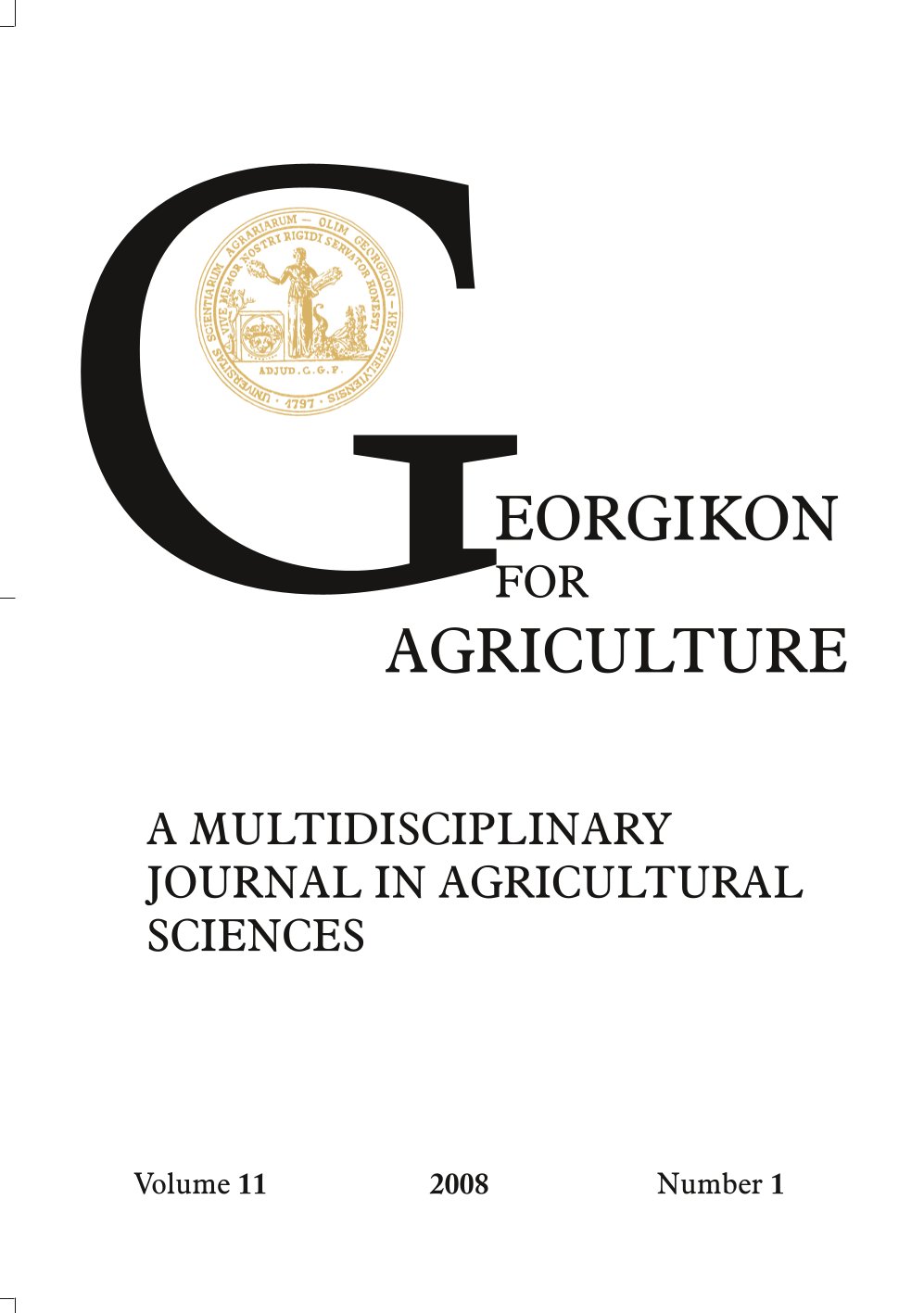Simulation of local plant temperature in maize at Keszthely as a result of global climate modification
Keywords:
simulation modeling, plant temperature, maizeAbstract
By applying the various scenarios on global warming we examined the crop temperature in maize at Keszthely with the help of Goudriaan’s micro-climate simulation model. Our scenarios contained several ideas with higher warming up beside the domestic downscaling of the IPCC 2007 report (A2 and B2). We found that the temperature in maize at cob level increased by 0.6 °C in Keszthely, compared to the 1961–1990s. The presence of the canopy slightly compensated the rise in plant temperature, even at simulations with rather high warming up. Compensation degree depended on water supply, too. The better water supply brings more intensive development of green surface of plants so provides stronger shadowing effect; this also affected the development of plant temperature.
References
Anda, A. 2006. Modeling maize response to climate modification in Hungary. (CBCS)Commun. Biometry Crop Sci. 1 (2) 90–98.
Anda, A. 2001a. Influence of crop water stress index on the development of maize hybrids. G. for Agric. 12 (1) 40–53.
Anda, A. 2001b. Az állományklímát befolyásoló néhány eljárás mikrometeorológiai elemzése. (Some micrometeorological processes determining the canopy microclimate.) In Hungarian. Akadémiai Doktori Értekezés (DSc Thesis)
Anda, A. 1993a Az infravörös termometria alkalmazása növényi vízforgalom meghatározására. (The use of infrared-thermometry in determination of plant water response) Kandidátusi értekezés Budapest.
Anda, A. 1993b Surface Temperature as an Important Parameter of Plant Stand.Időjárás. 97 (4) 259–269.
Anda, A. 2002. Slices of plant-water relation in reflection to investigations carried out at Agrometeorological Research Station of Keszthely. Időjárás. 106 (3–4) 137–160.
Anda, A., Decsi, É. K. 2001. Les componantes de la balance hydrique des deux type des mais différents dans les deux périodes de végétation successives. Acta Botanica Hung. 43 (3–4) 259–273. https://doi.org/10.1556/ABot.43.2001.3-4.3
Anda, A., Ligetvári, F. 1991. Infrared Thermometry in Scheduling Irrigation. ICID Bulletin, Spec. Tech. Session, Beijing, China. 1. 210–220.
Anda, A., Ligetvári, F. 1993. Potential Use of the Scheduler Plant Stress Monitor in Soybean. CATENA Soil Technology (Special Issue on Irrigation) 1. 137–144. https://doi.org/10.1016/0933-3630(93)90002-V
Anda, A., Lőke, Zs., Burucs, Z. 2001. Öntözött és természetes csapadékellátású kukorica mikroklímája. (Microclimate of irrigated and non irrigated maize) In Hungarian. Növénytermelés. 50 (2–3) 249–260.
Goudriaan, J. 1977: Crop Micrometeorology: A Simulation Study. Simulation Monographs. Pudoc, Wageningen.
Goudriaan, J., van Laar, H. H. 1994. Modelling Potential Crop Growth Processes. Kluwer Academic Publishers, Dordrecht-Boston-London. 238. p. https://doi.org/10.1007/978-94-011-0750-1
Haszpra, L. 2007. A légköri CO2 mérések negyedszázada Magyarországon (1981–2001). (CO2 measurements in the atmosphere at Hungary during the past 25 year.) In Hungarian. Légkör. 52 (1) 4–7.
IPCC (2007) Summary for Policymakers. In: Solomon, S., Qin, D., Manning, M., Chen, Z., Marquis, M., Averyt, K. B., Tignor, H. L., Miller, G. (Eds) Climate Change (2007) The Physical Science Basis. Contribution of Working Group I to the Fourth Assessment Report of the Intergovernmental Panel on Climate Change, Cambridge University Press, Cambridge, Available online: https://www.ipcc.ch
Jackson, R. D., Idso, S. B., Reginato, R. J., Pinter, P. J. Jr. 1981. Canopy temperature as a crop water stress indicator. Water Resour. Res. 17. 1133–1138. https://doi.org/10.1029/WR017i004p01133
Kocsis, T., Anda, A. 2005. Az éves csapadék-mennyiség változásának tendenciái Keszthelyen, 130 év mérése alapján. (Tendency in yearly precipitation sums at Keszthely as a result of 130 year observation.) In Hungarian. Légkör. 50 (2) 16–20.
Kocsis, T., Anda, A. 2006a. Keszthely léghőmérséklete a XX. században. (The air temperature of Keszthely in 20th century.) In Hungarian. Légkör. 51 (1) 21–24.
Kocsis, T., Anda, A. 2006b. A csapadék alakulása a keszthelyi hosszú idősoros meteorológiai megfigyelések alapján. (The precipitation of Keszthely by investigating long time series.) In Hungarian. J. Central Eur. Agric. 7 (4) 699–708.
Larcher, W.(ed.)1980: Physiological Plant Ecology. Springer Verlag, Berlin-Heidelberg-New York.
Mika, J. 2007. Regionális éghajlati forgatókönyvek előkészítése statisztikus módszerekkel. . (Preparation of climatic scenarios by using statistical methods). In Hungarian.Akadémiai Doktori Értekezés, Budapest
Prasad, P. V. V., Boote, K. J., Allen, L. H. Jr. 2006. Adverse high temperature effects on pollen viability, seed-set, seed yield and harvest index of grain-sorghum are more severe at elevated carbon dioxide due to higher tissue temperatures. Agric. and Forest Meteor. 139. 237–251. https://doi.org/10.1016/j.agrformet.2006.07.003
STATA 5.0. 1996. Stata Corporation LP Texas, USA. Available online: https://www.stata.com
SRES 2000. Emission Scenarios. IPCC Summary for Policymakers. https://www.ipcc.ch/pdf/special-reports/spm/sres-en.pdf
Willmott, C. J. 1982. Some comments on the evaluation of model performance. Bull. Am. Meteorol. Soc. 1309–1313. https://doi.org/10.1175/1520-0477(1982)063<1309:SCOTEO>2.0.CO;2
Downloads
Published
Issue
Section
License
Copyright (c) 2008 Dióssy László

This work is licensed under a Creative Commons Attribution-NonCommercial-NoDerivatives 4.0 International License.
Cikkre a Creative Commons 4.0 standard licenc alábbi típusa vonatkozik: CC-BY-NC-ND-4.0. Ennek értelmében a mű szabadon másolható, terjeszthető, bemutatható és előadható, azonban nem használható fel kereskedelmi célokra (NC), továbbá nem módosítható és nem készíthető belőle átdolgozás, származékos mű (ND). A licenc alapján a szerző vagy a jogosult által meghatározott módon fel kell tüntetni a szerző nevét és a szerzői mű címét (BY).




